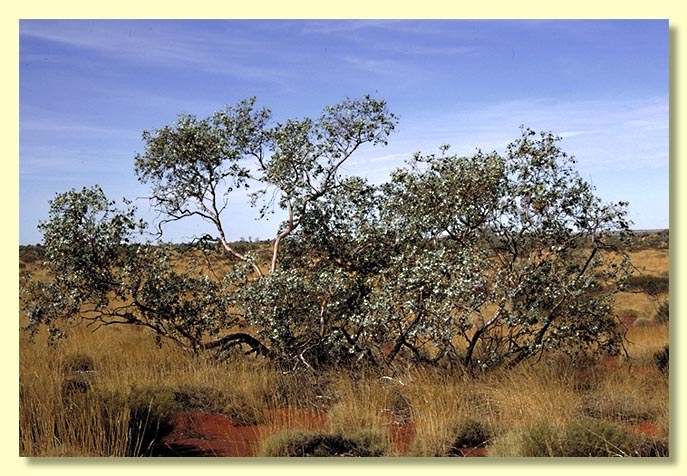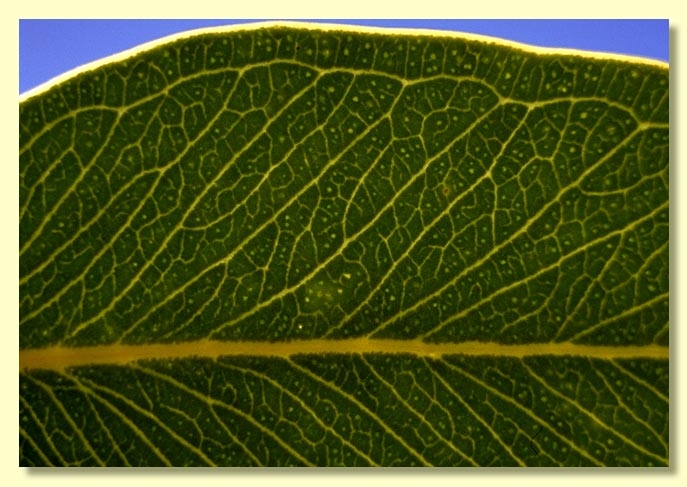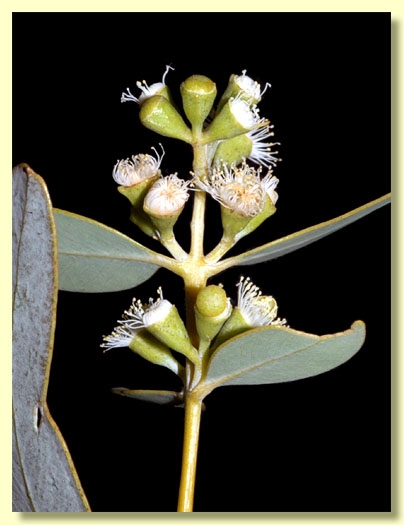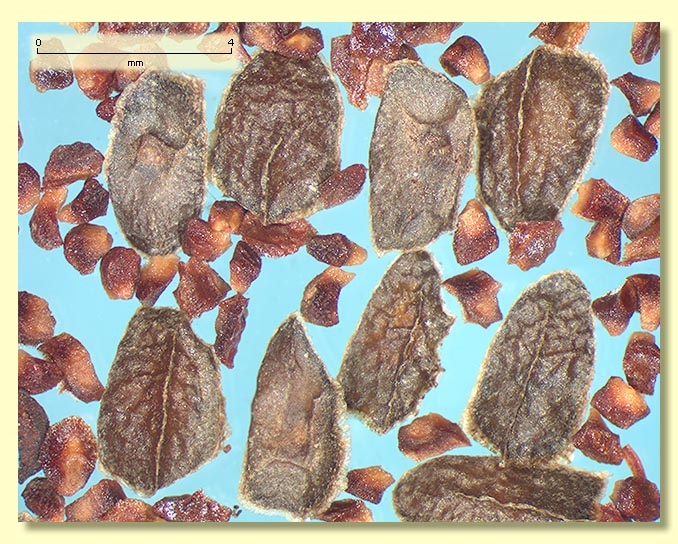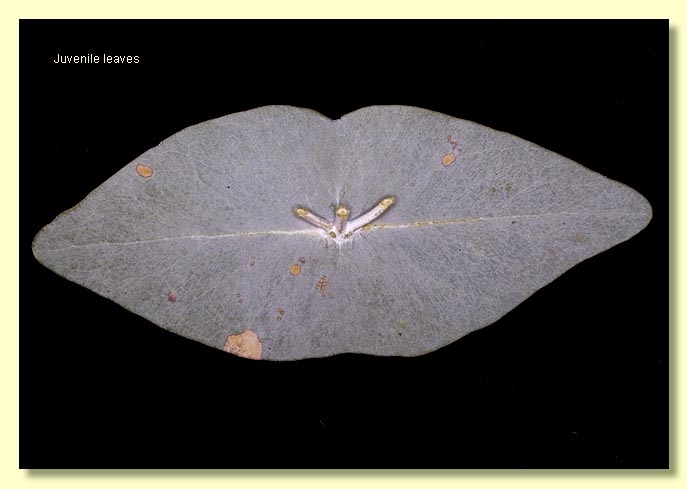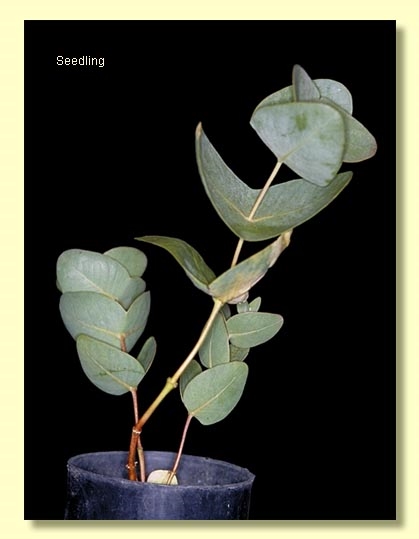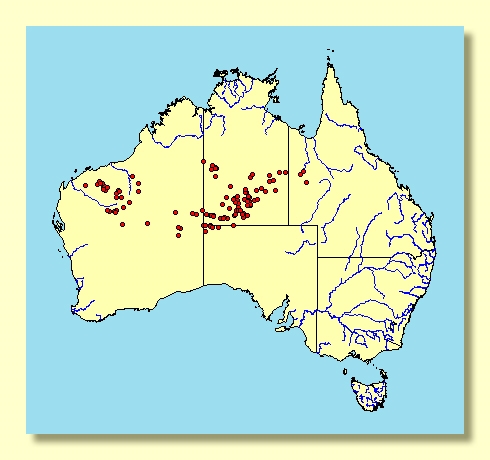Euclid - Online edition
Eucalyptus gamophylla
Eucalyptus | Eudesmia | Limbatae | Heteropterae | Patelliformes
T: Western Australia: Mount Pyrten, Hamersley Range, J.Forrest s.n.; holo: MEL.
Bark usually smooth throughout, white to grey to brown, sometimes cream to pink; occasionally with a short stocking of pale grey to yellowy brown rough flaky bark.
Branchlets glaucous; oil glands present in the pith but not always easy to find.
Juvenile growth (coppice or field seedlings to 50 cm): stems rounded in cross-section, glaucous, glabrous; juvenile leaves opposite and sessile, ovate to cordate, flat to slightly undulate, 3.5–10 cm long, 2–6 cm wide, base usually connate, sometimes amplexicaul to truncate, apex round to broadly acute, glaucous, glabrous.
True Adult leaves rare, mature crown usually with juvenile foliage.
Adult leaves when present are opposite to sub-opposite, petioles 0.1–0.6 cm long; blade lanceolate, 4–10 cm long, 0.9–2 cm wide, base tapering to petiole, concolorous, dull grey-green to green, side-veins at an acute or wider angle to midrib, tertiary venation moderate, intramarginal vein present, oil glands mostly island.
Inflorescence terminal compound or axillary compound to simple axillary, peduncles 0.5–1 cm long, buds 3 per umbel, pedicellate (pedicels 0.1–0.3 cm long). Mature buds clavate to pyriform (0.4–0.7 cm long, 0.3–0.4 cm wide), hypanthium slightly angled, glaucous, outer perianth whorl minutely sepaline, inner whorl operculate, operculum rounded, stamens grouped in four clusters (difficult to see once stamens have fully opened), usually inflexed but occasionally with outer stamens more or less erect, anthers oblong, versatile, dorsifixed, dehiscing by longitudinal slits (non-confluent), style long, stigma blunt, locules usually 3 or 4, the ovules usually arranged in 4 distinct vertical rows on the placentae, occasionally the arrangement indistinct. Flowers whitish.
Fruit pedicellate (pedicels 0.1–0.3 cm long), cylindrical to barrel-shaped, sometimes cup-shaped to obconical, 0.5–1.4 cm long, 0.5–0.8 cm wide, usually four-angled, glaucous, glaucescence diminishing with age, disc vertically descending, valves 3 or 4, enclosed.
Seeds pale brown to grey, boat-shaped, ventral side flattened, the dorsal side with a central longitudinal rib or keel, shallowly lacunose, 3–4 mm long, surface smooth, margin narrowly flanged in part, hilum ventral.
Cultivated seedlings (measured at node 10): cotyledons reniform; stems round in cross-section, glabrous, leaves sessile, opposite, ovate to cordate, 3.5–6 (8) cm long, 2.5–5 cm wide, glaucous to dull green, margins entire, apex broadly acute to rounded, base usually connate, rarely amplexicaul, lamina glabrous.
Flowering has been recorded in March, June, July, September, October, November and December.
A mallee species widespread in the arid centre and west of the Australian continent where it occurs on stony hills and red sand plains. Eucalyptus gamophylla is distributed from the Pilbara region of Western Australia east through the Little Sandy Desert, Carnegie, Warburton, Alfred and Marie Range, Blackstone and Rawlinson Ranges, extending into far north-western South Australia in the Mann Range and Musgrave Ranges. It is common amongst the ranges in the southern part of Northern Territory extending as far north as The Granites in the Tanami Desert, Barrow Creek, Harts Range, and the area between the south-eastern Davenport Range and Georgina Downs. In Queensland it is restricted to the far west of the state occurring from south of Mount Isa towards Dajarra and further south to the fringes of the Simpson Desert near Ethabuka. The bark is smooth, or rough on the lower half of the stems. The reproductively mature crown is composed of broad, glaucous, mostly connate juvenile leaves.
This juvenile crown with connate leaf pairs distinguishes E. gamophylla from any other species in the arid zone of southern Australia. The only other species having crown leaves with connate bases are E. risdonii, E. sturgissiana and E. perriniana, all of which come from the wetter parts of south-eastern Australia.
Eucalyptus gamophylla belongs in Eucalyptus subgenus Eudesmia because of the combination of cotyledons reniform in shape and folded and clasping in embryo, buds with the calyx either fused to the corolla and evident as four small teeth at the apex of the bud or with the calyx free and evident as four small teeth around the midline of the bud and stamens often arranged in four bundles. Within subgenus Eudesmia, E. gamophylla belongs in the Section Limbatae, series Heteropterae, subseries Patelliformes and is distinctive and taxonomically somewhat isolated because of its flattened seeds with dorsal keel and partial marginal flange, buds with minute free sepals around the midline of the bud, sessile or connate glabrous seedling and juvenile growth, and its lack of oil glands in the pith of the branchlets. This combination of characters is only shared with the closely related E. odontocarpa, from northern Australia. E. odontocarpa is the fully adult form of the species pair and is easily recognised by the narrow, glossy adult leaves. Forms intermediate between the two species are common and should be simply referred to as such.

